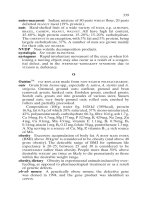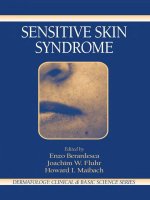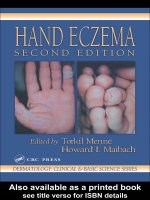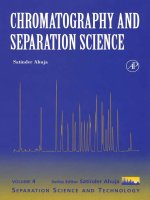(Separation science series) thomas e beesley, raymond p w scott chiral chromatography j wiley (1998)
Bạn đang xem bản rút gọn của tài liệu. Xem và tải ngay bản đầy đủ của tài liệu tại đây (4.26 MB, 552 trang )
Page i
Chiral Chromatography
www.pdfgrip.com
Page ii
SEPARATION SCIENCE SERIES
Editors: Raymond P.W. Scott, Colin Simpson and Elena D. Katz
Quantitative Analysis using
Chromatographic Techniques
Edited by Elena D. Katz
The Analysis of Drugs of Abuse
Edited by Terry A. Gough
Liquid Chromatography Column Theory
Edited by Raymond P.W. Scott
Silica Gel and Bonded Phases:
Their Production, Properties and Use in LC
Edited by Raymond P.W. Scott
Capillary Gas Chromatography
Principles and Methods in Biotechnology
by David W. Grant
High Performance Liquid Chromatography:
Principles and Methods in Biotechnology
Edited by Elena D. Kratz
Tandem Techniques
by Raymond P.W. Scott
Chiral Chromatography
by Thomas E. Beesley and Raymond P.W. Scott
www.pdfgrip.com
Page iii
Chiral Chromatography
by
Thomas E. Beesley
Advanced Separation Technology Inc., New York, USA
and
Raymond P.W. Scott
Georgetown University, Washington DC, USA
and
Birkbeck College, University of London, UK
www.pdfgrip.com
Page iv
Copyright © 1998 by John Wiley & Sons Ltd.
Baffins Lane, Chichester
West Sussex PO19 1UD, England
National Chichester (01243) 779777
International (+44) 1243 779777
e-mail (for orders and customer service enquiries):
Visit our Home Page on
or
All rights reserved. No part of this publication may be reproduced, stored in a retrieval system, or
transmitted, in any form or by any means, electronic, mechanical, photocopying, recording, scanning or
otherwise, except under the terms of the Copyright, Designs and Patents Act 1988 or under the terms of
a licence issued by the Copyright Licensing Agency, 90 Tottenham Court Road, London, W1P 9HE,
UK, without the permission in writing of the publisher.
Other Wiley Editorial Offices
John Wiley & Sons, Inc., 605 Third Avenue,
New York, NY 10158-0012, USA
Wiley-VCH Verlag GmbH, Pappelallee 3,
D-69469 Weinheim, Germany
Jacaranda Wiley Ltd, 33 Park Road, Milton,
Queensland 4064, Australia
John Wiley & Sons (Asia) Pte Ltd, 2 Clementi Loop #02-01,
Jin Xing Distripark, Singapore 129809
John Wiley & Sons (Canada) Ltd, 22 Worcester Road,
Rexdale, Ontario M9W 1L1, Canada
British Library Cataloguing in Publication Data
A catalogue record for this book is available from the British Library
ISBN 0 471 97427 7
Produced from camera ready copy supplied by the authors
Printed and bound in Great Britain by Bookcraft (Bath) Ltd
This book is printed on acid-free paper responsibly manufactured from sustainable
forestry, in which at least two trees are planted for each one used for paper production.
www.pdfgrip.com
Page v
Preface
In the world of science, nothing invigorates the mind so much as to watch a concept develop from some
small seed of discovery to a universally applicable technology. In the last four decades,
chromatography, the once mysterious and very crude technique, has grown into a very sophisticated and
reliable separation methodology. Over the last decade, the application of the accumulated knowledge to
the once esoteric field of chiral separations has made impressive advances particularly in the last three
years. The chromatography of enantiomers has required the preparation of highly structured phases,
which had to be designed to have a direct bearing on the nature and the chemistry of the materials to be
separated. New terms had to be introduced and defined, such as three point interaction and inclusion
complexation to describe some of the new interactive mechanisms that were invoked. As will be
apparent from this book, however, the basic chromatography terms and the physical chemical principles
that determine that a chromatographic separation is possible remain the same. In dealing
comprehensively with the subject of chiral chromatography, a significant amount of theory must be
included, but we have tried to present this in a manner that explains the interactions that takes place and
provides a rational direction that can be taken to solve practical problems.
Having been involved in chromatography for many years (our combined experience extending over
three quarters of a century) we find it gratifying to see the very substantial increases in successful chiral
separations that are currently published in the field. Starting from the pioneering work of Gil-Av (1966)
and Bayer (1974) followed by that of Okamato and Pirkle and culminating with the recent, highly
innovative phases, introduced by Armstrong, chiral chromatography has now reached a high degree of
sophistication. The creation of the cyclodextrin phases and the introduction of the macrolytic antibiotics
by Armstrong has brought new incentives to the field and many new areas of application.
This book has been written to serve both the novice in the field and the experienced chromatographer.
In addition to giving detailed information on chiral separations, it also discusses the principles involved
in chiral selectivity and, for those new to the technique, describes the fundamentals of a
chromatographic separation and the essential apparatus needed to carry it out. To make the book as
complete as possible we have included chapters on preparative chiral chromatography and some basic
www.pdfgrip.com
Page vi
information on chiral capillary electrophoresis and electro-chromatography. Finally, to help readers
choose the correct phase system and operating conditions for their particular sample, we have
incorporated experimental selection schemes for the four major chiral stationary phases that are
commercially available.
THOMAS. E. BEESLEY
RAYMOND P. W. SCOTT
NOVEMBER 1998
www.pdfgrip.com
Page vii
Acknowledgments
In the preparation of any technical book, information must be gathered from a variety of sources. The
authors would like to take this opportunity to thank the many journals who have granted us permission
to reproduce diagrams from their publications, and those chromatography vendors who have supplied
us with the technical details of their products. In particular, we would like to thank the companies
Advanced Separations Technologies Inc. (ASTEC), Chromtech AB, Regis Technologies, Chiral
Technologies, and Supelco for providing both technical data and permission to reproduce their product
bibliographies. Special thanks are also due to Advanced Separations Technologies Inc. (ASTEC) who
contributed laboratory facilities for data collection and to their staff members, Dr. Heng Liang Jin and
Mr. B Buglio, who helped provide the chiral retention data that is used in the optimization procedures.
Finally, thanks are due to the production department of John Wiley and Sons for their careful review of
the manuscript before publication. In particular we appreciate the efforts of Mr. Martin Tribe and his
assistants for their much appreciated comments and advice.
THOMAS E. BEESLEY
RAYMOND P. W. SCOTT
OCTOBER 1998
www.pdfgrip.com
Page ix
Contents
Chapter 1
An Introduction to Chiral Chromatography
1
An Historical Perspective
1
A Short Introduction to Stereochemistry
3
Polarization Modulation
7
Practical Chiral Measuring Devices
8
Configuration Specifications
15
Diastereoisomers
18
Anomers
20
Epimers
20
Meso Structures
22
Separation Techniques for Chiral Chemistry
23
Synopsis
25
References
27
Chapter 2
Mechanism of Solute Retention
29
The Plate Theory
30
The Retention Volume of a Solute
34
The Capacity Ratio of a Solute
37
The Separation Ratio
38
www.pdfgrip.com
The Thermodynamic Properties of the Distribution Coefficient
39
The Availability of the Stationary Phase
47
Synopsis
50
References
51
Chapter 3
Molecular Interactions
53
Dispersion Forces
54
Polar Forces
56
Dipole-Dipole Interactions
57
Dipole-Induced-Dipole Interactions
59
www.pdfgrip.com
Page x
Ionic Forces
60
Hydrophobic and Hydrophilic Interactions
61
Molecular Interactions in Mixed Phases
65
Chiral Additives
72
Synopsis
76
References
77
Chapter 4
The Basic Gas Chromatograph
79
Gas Supplies
81
Sampling Devices
83
Injection Systems for Packed Columns
83
Injection Systems for Small Diameter Capillary Columns
85
Injection Systems for Large Bore Capillary Columns
86
Automatic Injection Systems
88
The Column Oven and Temperature Programmer
88
Detectors
89
Detector Specifications
90
Detector Response
93
Detector Sensitivity or Minimum Detectable Concentration
93
Pressure Sensitivity
94
Flow Sensitivity
95
Temperature Sensitivity
95
www.pdfgrip.com
The Flame Ionization Detector
95
The Nitrogen Phosphorous Detector (NPD)
97
The Electron Capture Detector
98
The Katharometer (Thermal Conductivity and Hot Wire) Detector
101
Data Acquisition and Processing
103
Synopsis
104
References
106
Chapter 5
GC Chiral Stationary Phases and Columns
107
Early Days in Chiral GC
108
Chiral Stationary Phases for Gas Chromatography
112
Small Molecule Stationary Phases
112
Chiral Polysiloxane Stationary Phases
114
Chiral Metal Chelating Stationary Phases
116
Cyclodextrin Chiral Stationary Phases
119
www.pdfgrip.com
Page xi
Factors Controlling Selectivity
123
Open Tubular Columns
124
Dynamic Coating
125
Static Coating
127
Column Regeneration
127
Capillary Column Design and Choice
129
Stationary Phases for the GC Separation of Chiral Substances
136
Synopsis
138
References
140
Chapter 6
Chiral Gas Chromatography Applications
141
The Basic Principles of Chiral Selectivity
141
Test Mixtures
143
Elution Reversal of Enantiomers
146
Selectivity Characteristics of the Different Cyclodextrins
149
The Effect of Solute Derivatization on Chiral Selectivity
154
Chiral Separations of Essential Oils
156
Pharmaceutical Applications of Chiral Gas Chromatography
165
General Applications of Chiral Chromatography
169
Synopsis
171
References
172
173
Chapter 7
www.pdfgrip.com
The Basic Liquid Chromatograph
The Basic LC Layout
173
Mobile Phase Reservoirs
174
The Solvent Programmer
175
The High-Pressure Mixing Solvent Programmer
175
The Low-Pressure Mixing Solvent Programmer
176
The Mobile Phase Pump
176
The Sample Valve
178
The Column and Column Oven
181
Liquid Chromatography Detectors
185
The UV Detector
185
The Fixed Wavelength Detector
187
The Multi-Wavelength Detector
188
The Diode Array Detector
189
The Electrical Conductivity Detector
193
www.pdfgrip.com
Page xii
The Fluorescence Detector
195
The Light Scattering Detectors
197
The Multiple Angle Laser Light-Scattering (MALS) Detector
201
The Refractive Index Detector
204
Chiral Detectors
207
Data Acquisition and Processing
212
Synopsis
215
References
219
Chapter 8
Liquid Chromatography Chiral Stationary Phases
Chiral Stationary Phases
221
229
Protein Based Stationary Phases
230
The Pirkle Type Stationary Phases
235
Coated Cellulose and Amylose Derivatives
239
Macrocyclic Glycopeptide Stationary Phases
242
Cyclodextrin Based Chiral Stationary Phases
253
Synopsis
261
References
263
Chapter 9
Preparation of LC Chiral Phases and Columns
265
The Supporting Matrix for Chiral Stationary Phases
265
The Preparation of Protein Stationary Phases
268
www.pdfgrip.com
The Preparation of the Pirkle Stationary Phases
270
The Preparation of Cellulose and Amylose Stationary Phases
273
The Preparation of the Macrocyclic Glycopeptides Phases
275
The Preparation of the Cyclodextrin Based Stationary Phases
277
Column Packing Techniques
281
Mechanical Packing Equipment
286
Radial Compression Packing
287
Axial Compression Packing
288
Synopsis
289
References
290
www.pdfgrip.com
Page xiii
Chapter 10
Column Temperature and Mobile Phase Composition: Their Effect on
Column Length and Analysis Time
291
An Optimization Procedure for a Chiral Separation
297
The Experimental Determination of f R (X ϕ), f S (X ϕ), f R(T,Xϕ) and f S
(T,Xϕ)
301
Synopsis
313
References
314
Chapter 11
Chiral Liquid Chromatography Applications
The Protein Stationary Phases
317
318
The Separation of the Enantiomers of Epibatidine
321
Techniques for Improving the Detection Sensitivity of the
Enantiomers of a Leukotriene Antagonist
322
The Separation of the Enantiomers of Vamicamide Contained in
Blood Serum and Urine
325
The Pirkle Stationary Phases
327
The Separation of the Enantiomers of Some Amino Acids
327
The Effect of the Chain Length of the Mobile Phase Dispersive
Solvent Component on Chiral Resolution
329
Stationary Phase Modification to Improve the Separation of
Naproxen Enantiomers
331
The Separation of the Fullerenes
334
The Cellulose and Amylose Stationary Phases
The Separation of Some Chiral Drugs on Different Cellulose
Derivatives
www.pdfgrip.com
336
339
The Separation of the Enantiomers of Propranolol, Metroprolol and
Atenolol
342
The Separation of the Enantiomers of Two Anticonvulsants
344
The Macrocyclic Glycopeptide Stationary Phases
347
The Separation of the Enantiomers of Three Racemic Substituted
Pyidones
347
Examples of the Use of Vancomycin in Both the Normal Phase and
Reverse Phase Modes
349
The Separation of the Enantiomers of Ibuprofen on Vancomycin
354
The Separation of the Isomers of Citalopram
355
The Separation of the Isomers of 2-and 3-Bromophenylalanine
357
The Cyclodextrin Based Stationary Phase
The Use of a Cyclodextrin Based Stationary Phase to Separate
Blocking Agents
www.pdfgrip.com
358
358
Page xiv
The Determination of Enantiomers in Blood Serum by Direct
Injection
361
The Use of 2-Quinoxal Chloride for Precolumn Derivatization
362
The Separation of the Chlorophenols on β-Cyclodextrin Bonded
Phase
364
The Separation of Major Soybean Phospholipids on β-Cyclodextrin
Bonded Silica
366
The Separation of Porphyrins on a γ-Cyclodextrin Stationary Phase
368
Synopsis
371
References
372
Chapter 12
Preparative Chiral Chromatography
375
The Loading Capacity of a Column
376
The Maximum Sample Volume
379
Sample Volume Overload
381
Sample Mass Overload
385
Preparative Chromatography Apparatus
388
Solvent Reservoirs
389
Pumps
390
Sample Valves
390
Preparative Columns
390
Preparative Detectors
391
Fraction Collectors
391
www.pdfgrip.com
Solvent Hazard
392
Packing Preparative Columns
392
Recycling Development
393
Alternative Preparative Techniques
397
The Moving Bed Continuous Chromatography System
398
The Simulated Moving Bed Preparative Chromatography System
401
Radial Flow Chromatography
405
The Preparative Separation of the Enantiomers of Chlorokynurenine
409
Synopsis
410
References
411
Chapter 13
Chiral Separations by Capillary Electrophoresis and Capillary
Electrochromatography
413
Capillary Electrophoresis
413
Isotachophoresis
414
Isoelectric Focusing
415
Electro-Osmotic Flow (Electro-Endosmosis)
417
www.pdfgrip.com
Page xv
Application Examples
425
The Separation of Peptides
425
The Separation of the Stereoisomers of a Mixture of
Pseudoephedrine and Ephedrine
427
The Effect of pH on the Separation of Duloxetine Enantiomers
Using Hydroxypropyl-β -Cyclodextrin Additives
428
The Separation of the Enantiomers of Some Amino Acids with the
Chiral Additive Vancomycin
429
The Separation of Some enantiomers by Counter Current Capillary
Electrophoresis
431
Synopsis
433
References
434
Chapter 14
An Experimental Approach to Chiral Chromatography
437
Introduction
437
Chiral Gas Chromatography
439
Derivatization
439
The Polysiloxane Based Stationary Phases
441
The Amino Acid-Peptide Polysiloxane Stationary Phases
441
Peptide-Dimethylpolysiloxane Chiral Stationary Phases
442
Peptide-Phenylpolysiloxane Chiral Stationary Phases
442
Cyanopolysiloxane Peptide Chiral Stationary Phases
442
The Polysiloxane-Cyclodextrin Based Stationary Phases
443
Chiral Liquid Chromatography
446
www.pdfgrip.com
The Protein Based Stationary Phases
446
Chiral-AGP
447
Chiral-HSA
449
The Cellulose Based Stationary Phases
451
The Pirkle Stationary Phases
454
The Macrocyclic Glycopeptide Bonded Phases
457
The Cyclodextrin Bonded Phases
460
Bibliography
465
The Protein Phases
465
The Pirkle Stationary Phases
473
The Cellulose and Amylose Stationary Phases
476
The Macrocyclic Glycopeptide Stationary Phases
482
The Cyclodextrin Based Stationary Phases
483
Appendix
497
Index
499
www.pdfgrip.com
Page 1
Chapter 1—
An Introduction to Chiral Chromatography
An Historical Perspective
Until relatively recently, interest in chiral chemistry has been largely academic and, as a consequence,
has occupied a relatively minor position in the analytical chemistry syllabuses of most universities.
Despite the emphasis that has been placed on the recent advances in chiral chemistry, optical isomers
have been know for many years and were first identified by Biot [1] in the early 1800s, and their
existence was established by the work of Pasteur [2] in 1848. Both van't Hoff [3] and Le Bel [4]
proposed the existence of the asymmetric carbon atom and used it to explain the cause of optical
rotation. However, it was Emil Fisher [5], who made the first serious attempts to relate the absolute
stereochemistry of optical isomers and determined the configuration of (+)-glucose for which he
received the Nobel prize. Fisher predicted that the (+)-isomer of glyceraldehyde was the D-isomer and
arbitrarily assigned the stereochemistry as;
Fisher's assumption was later proved correct by Bijovet [6] using X-ray crystallography. Thus, the
foundations of chiral chemistry were
www.pdfgrip.com
Page 2
established. The study of stereochemistry progressed steadily, albeit relatively slowly, for some years.
However, about 1980, there was a sudden increase in the commercial interest in chiral substances,
particularly chiral drugs, and this interest proliferated very rapidly. This new enthusiasm was fostered
by the discovery that the respective physiological activity of the isomers of a drug could differ radically
and this was found to be true for many physiologically active compounds and, in particular,
physiologically active biotechnology products. However, the major stimulation arose from the
unfortunate birth defects initiated by one of the enantiomers of Thalidomide. This drug was
manufactured and sold as a racemic mixture of N-phthalylglutamic acid imide. However, the desired
physiologically activity was found to reside solely in the R-(+)-isomer and it was discovered, too late,
that the corresponding S-(-)-enantiomer was teratogenic and caused serious fetal malformations.
The thalidomide disaster evoked the interest of all pharmaceutical manufacturers and also the drug
regulatory committees. Research activity in the field of stereochemistry became almost frenetic. The
United States Food and Drug Administration recommended that each isomer of all new drugs should be
individually tested, forcing companies to address the possible problems associated with enantiomeric
mixtures. The demand for enantiomerically pure drugs rose rapidly and a few years ago (1993), the
world market in enantiomerically pure drugs exceeded $35 million, and of that total, nearly two thirds
were cardiovascular and antibiotic drugs. The mandate to test the different enantiomers of a drug
evoked the need for appropriate analytical procedures to separate and quantitatively assay them. A
decade ago, there were very few effective techniques available.
In early 1980, few commercial stationary phases for either gas chromatography or liquid
chromatography were available. Nevertheless, in 1966 Gil-Av et al., [7], had described the first chiral
stationary phase for gas chromatography and in 1976 Sogah and Cram [8] introduced chiral crown
ethers as stationary phases. In 1978, Harada et al. [9]
www.pdfgrip.com
Page 3
introduced the cyclodextrins as chiral separation agents and, in 1980, Armstrong [10] used the
cyclodextrins as mobile phase additives for chiral separations by thin-layer chromatography. Today, the
cyclodextrins are one of the more common chiral agents used in chromatography and electrophoresis
for the separation of enantiomers, although other reagents, such as those based on cellulose, have found
many areas of application. However, to appreciate the difficulties involved in the separation of
enantiomers, and the mechanism by which they are selectively retained on chiral phases, some basic
understanding of chiral chemistry is necessary.
A Short Introduction to Stereochemistry
Stereochemistry is not primarily germane to the subject of this book, and it is not intended to discuss
the subject in any detail. Nevertheless, the basic concepts, definitions and conventions, currently used in
stereochemistry, will be considered to help those less familiar with the subject to understand the
separation technology that will be introduced and described in the subsequent chapters. Stereochemistry
is the study of the three-dimensional structure of chemical compounds. Isomers of the same substance,
that only differ in the spatial arrangement of their atoms are called stereoisomers. Certain stereoisomers
that differ only in their capacity for rotating the plane of polarized light passed through them, are
termed optically active, or chiral, and the isomers are called enantiomers. It follows, that as the subject
of this book pertains to the separation of chiral substances, the method used for measuring optical
activity needs to be briefly described.
Optical activity was originally measured by means of a polarimeter, the principle of which is depicted
in figure 1.1. Light from an appropriate source passes through a polarizer, typically consisting of a set
of crossed Nichol prisms, which produces a beam of plain polarized light usually polarized vertically.
The vertically polarized light then passes through a sample tube containing the optically active
substance. The light is rotated in the sample cell and transmitted with the plane of polarization turned
through an angle, the magnitude of which is determined by the nature of the substance and its
concentration in solution. The light then passes
www.pdfgrip.com









